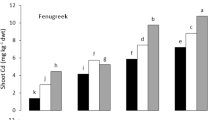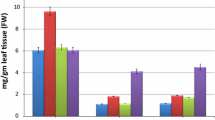Abstract
A field experiment was designed to investigate the effects of cadmium and lead on biomass production, sugar and vitamin C content of dietary vegetables. At seedling stage the reduction magnitudes in biomass production with added cadmium up to 50 mg kg−1 soils were 49–51 % in fenugreek root and 32.2–39.6 % in spinach leaf; while at 40 days after sowing (vegetative growth stage); they were observed as 36.1–47.2 % in spinach root and 17.8–20 % in coriander leaf. Cadmium caused maximum reduction in sugar content (62 %) in radish leaf and vitamin C content (56.4 %) in coriander leaf at seedling stage; whereas, maximum reduction in sugar content (66.7 %) and vitamin C content (59.4 %) was observed in spinach leaf and coriander leaf, respectively, under the combined treatment (Cd 50 mg kg−1 + Pb 500 mg kg−1) at vegetative growth stage. The dietary vegetables enhance their antioxidant activity against metal stress when applied below the critical level, however, dosage of Cd higher than critical level (≥25 mg kg−1 soil in treatments II, III and IX) drastically alters plant growth (stunted), reduced yield as well as dietary contents (sugar and vitamin C) of these important vegetables especially it’s antioxidant content; and the hazardous effect was more visible at higher bioaccumulation of heavy metals during vegetative growth stage. It is concluded that dietary vegetables should be utilized for human consumption before the vegetative growth stage especially in the soils polluted with cadmium and lead in order to minimize the intake of pollutants.


Similar content being viewed by others
References
Ifron ET, Basir O (1979) Nutritive value of some Nigerian leafy vegetables part 3. Food Chem 5:231–235
Gockowski J, Mbazo’o G, Mbah TF (2003) African traditional leafy vegetables and the urban and peri-urban poor. Food Policy 28:221–235
Szeto YT, Tomlinson B, Benzie IF (2002) Total antioxidant and ascorbic acid content of fresh fruits and vegetables: implications for dietary planning and food preservation. Br J Nutr 87(1):55–59
Igbal K, Khan A, Khattak MAK (2004) Biological significance of ascorbic acid (vitamin C) in human health-a review. Pakistan J Nutri 3(1):5–13
Gholamabbas S, Majid A, Sayed FM, Karim CA, Brian KR, Rainer S (2010) Transport of Cd, Cu, Pb and Zn in a calcareous soil under wheat and safflower cultivation––a column study. Geoderma 154:311–320
Angelova A, Ivanova K, Ivanova R (2004) Effect of chemical forms of lead, cadmium, and zinc in polluted soils on their uptake by tobacco. J Plant Nutri 27(5):757–773
Yusuf AA, Arowolo TA, Bamgbose O (2003) Cadmium, copper and nickel levels in vegetables from industrial and residential areas of Lagos City, Nigeria. Food Chem Toxicol 41:375–378
Gupta UC, Gupta SC (1998) Trace element toxicity relationships to crop production and livestock and human health: implications for management. Commun Soil Sci Plant Anal 29:1491–1522
Bolan NS, Duraisamy VP (2003) Role of inorganic and organic soil amendments on immobilization and phyto-availability of heavy metals: a review involving specific case studies. Aust J Soil Res 41:533–555
Carlos A, Constantin L, Garcia FP, Razo LMD, Vazquez RR, Varaldo HMP (2005) Chemical fraction of heavy metals in soils irrigated with waste water in central Mexico. Agric Eco Environ 108:57–71
Vassilev A, Perez SA, Semane B, Carleer R, Vangronsveld J (2005) Cadmium accumulation and tolerance of two salix genotypes hydrophonically grown in presence of cadmium. J Plant Nutri 28:2159–2177
Lindsay WL, Norvell WA (1978) Development of a DTPA soil test for zinc, iron, manganese and copper. Soil Sci Soc Am J 42:421–428
Walkley A, Black AI (1934) An examination of the Degtjareff method for determining soil organic matter and a proposed modification of chromic acid titration method. Soil Sci 37:29–38
Chopra SL, Kanwar JS (1999) Analytical agricultural chemistry. Kalyani Publication, New Delhi
Kumar C, Mani D (2010) Enrichment and management of heavy metals in sewage-irrigated soil. Lap LAMBERT Acad Publishing, Dudweiler (Germany)
Allen SE, Grimshaw HM, Rowland AP (1986) Chemical analysis. In: Moore PD, Chapman SB (eds) Methods in plant ecology. Blackwell Scientific Publication, London, pp 285–344
Al-Ani M, Opara LU, Al-Bahri D, Al-Rahbi N (2007) Spectrophotometric quantification of ascorbic acid contents of fruit and vegetables using the 2,4-dinitrophenylhydrazine method. J Food Agric Environ 5(3 &4):165–168
Kharn MMR, Rahman MM, Islam MS, Begum SA (2006) A simple UV-spectrophotometric method for the determination of vitamin c content in various fruits and vegetables at Sylhate area in Bangladesh. J Biol Sci 6(2):388–392
Qingling Fu, Hongqing Hu, Li Jiajia, Li Huang, Haizheng Y, Lv Yi (2009) Effects of soil polluted by cadmium and lead on production and quality of pepper (Capsicum annuum L.) and radish (Raphanus sativus L.). J Food Agric Environ 7(2):698–702
Li X, Coles BJ, Ramsey MH, Thornton I (1995) Sequential extraction of soils for multi-element analysis by ICP-AES. Chem Geol 124:109–123
Dang YP, Chhabra R, Verma KS (1990) Effect of Cd, Ni, Pb and Zn on growth and composition of onion and fenugreek. Commun Soil Sci Plant Anal 21(9/10):717–735
Pandey N, Sharma CP (2002) Effect of heavy metals Co2+, Ni2+ and Cd2+ on growth and metabolism of cabbage. Plant Sci 163:753–758
Muhammad A, Zahida P, Muhammad I, Riazuddin Iqbal S, Ahmed M, Bhutto R (2010) Monitoring of toxic metals (cadmium, lead, arsenic and mercury) in vegetables of Sindh Pakistan. Kathmandu Univ J Sci Eng Technol 6(2):60–65
Padmaja K, Prasad DDK, Prasad ARK (1990) Inhibition of chlorophyll synthesis in Phaseolus vulgaris seedling by cadmium acetate. Photosynthetica 24:399–405
Arduini I, Godbold DL, Onnis A (1996) Cadmium and copper uptake and distribution in Mediterranean tree seedlings. Physiol Plant 97:111–117
Haluskov L, Valentovicova K, Huttova J, Mistrik I, Tamas L (2010) Elevated indole-3-acetic acid peroxidase activity is involved in the cadmium-induced hydrogen production in barley root tip. Plant Growth Regul 62(1):59–64
John R, Ahmad P, Gadgil K, Sharma S (2009) Heavy metal toxicity: effect on plant growth biochemical parameters and metal accumulation by Brassica juncea L. Int J Plant Prod 3(3):65–75
Fang-YI Chu, Sun JIE, Xianzhong WU, Rui Hai LIU (2002) Antioxidant and anti-proliferative activities of common vegetables. J Agric Food Chem 50:6910–6916
Rajeshwari CU, Andallu B (2011) Oxidative stress in NIDDM patients: influence of coriander (Coriandrum sativum) seeds. Res J Pharm Biol Chem Sci 2(1):31
Ogunlesi M, Okiei W, Azeez L, Obakachi V, Osunsanmi M, Nkenchor G (2010) Vitamin C contents of tropical vegetables and foods determined by voltametric and titrimetric methods and their relevance to the medicinal uses of the plants. Int J Electrochem Sci 5:105–115
Girisha ST, Ragavendra BV (2009) Accumulation of heavy metals in leafy vegetables grown in urban areas by using sewage water and its effect. Arch Phytopathol Plant Prot 42(10):956–959
Abbas M, Parveen Z, Iqbal M, Riazuddin Iqbal S, Ahmed M, Bhutto R (2010) Monitoring of toxic metals (cadmium, lead, arsenic and mercury) in vegetables of spinach, Pakistan. Kathmandu Univ J Sci Eng Technol 6(2):60–65
Jiang W, Liu D, Hou W (2000) Hyperaccumulation of lead by roots hypocotyles and shoots of Brassica juncea. Biol Plant 43(4):603–606
Bigdeli M, Seilsepour M (2008) Investigation of metals accumulation in some vegetables irrigated with waste water in Shahre Rey-Iron and toxicological implications. American-Eurasian J Agric Environ 4(1):86–92
Singh RP, Agrawal M (2007) Effect of sewage sludge amendment on heavy metal accumulation and consequent responses of Beta vulgaris plants. Chemosphere 67:2229–2240
Sharma RK, Agrawal M, Marshall F (2006) Heavy metals contamination in vegetables grown in waste water irrigated areas of Varanai, India. Bull Environ Contam Toxicol 77:312–318
Ismail BS, Farihah K, Khairiah J (2005) Bioaccumulation of heavy metals in vegetables from selected agricultural areas. Bull Environ Contam Toxicol 74:320–327
Hounsome N, Hounsome B, Tomos D, Edwards JG (2008) Plant metabolites and nutritional quality of vegetables. J Food Sci 73(4):48–65
Singh RK, Sudhakar A, Lokeshwar BL (2011) From normal cells to malignancy: distinct role of pro-inflammatory factors and cellular redox mechanisms. J Cancer Sci Ther 03:70–75
Al-Madani WA, Siddiqi NJ, Alhomida AS (2009) Renal toxicity of mercuric chloride at different time intervals in rats. Biochem Insights 02:37–45
Mani D, Sharma B, Kumar C (2007) Phytoaccumulation, interaction, toxicity and remediation of cadmium from Helianthus annuus L. (sunflower). Bull Environ Contam Toxicol 79:71–79
UNCTAD (2003) Organic fruit and vegetables from the Tropic, United Nations Conference on Trade & Development (UNCTAD), Geneva 10, Switzerland, 203–210
Mani D, Kumar C, Srivastava RK (2007) Effect of calcium, zinc and organic matter on the uptake of cadmium in Brassica rapa L. (turnip). Proc Natl Acad Sci India 77(2):263–276
Acknowledgments
The research was supported by The National Academy of Sciences, India (Allahabad), the Sheila Dhar Memorial Scholarship Fund and the Indian Farmer Fertilizer Cooperative (IFFCO) Ltd., Phulpur Unit, Ghiya Nagar, Phulpur Allahabad-212404, Uttar Pradesh, India. Opinions in the paper do not constitute an approval by the funding agencies but only reflect the personal views of the authors.
Author information
Authors and Affiliations
Corresponding author
Rights and permissions
About this article
Cite this article
Mani, D., Sharma, B., Kumar, C. et al. Cadmium and Lead Bioaccumulation During Growth Stages Alters Sugar and Vitamin C Content in Dietary Vegetables. Proc. Natl. Acad. Sci., India, Sect. B Biol. Sci. 82, 477–488 (2012). https://doi.org/10.1007/s40011-012-0057-6
Received:
Revised:
Accepted:
Published:
Issue Date:
DOI: https://doi.org/10.1007/s40011-012-0057-6




